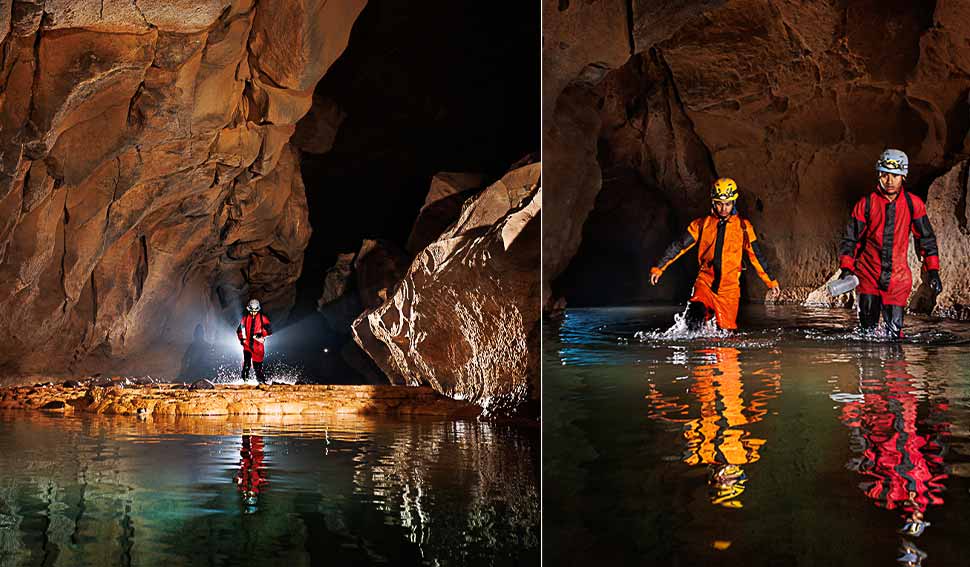Lungchun Khur in Meghalaya now ranks among India’s longest caves

Meghalaya’s underground world continues to astound as the latest edition of the Caving in the Abode of the Clouds Expedition successfully mapped 22,663 meters of previously unexplored cave passages. Conducted from February 2 to February 28, the expedition was organized by the Meghalaya Adventurers Association (MAA) in collaboration with an international team of cavers. This year’s focus was on the limestone cave systems of Byrong, Jongria, and the Muallian Spur, where explorers uncovered vast underground river passages, intricate chamber networks, and relic formations.
Brian D. Kharpran Daly, General Secretary of MAA, hailed the findings as a significant step in Meghalaya’s ongoing cave exploration efforts. He emphasized that the discovery of Lungchun Khur and other large cave systems highlights the state’s immense potential for further subterranean discoveries. He stated that each year, new passages contribute to a deeper understanding of these hidden landscapes, reinforcing Meghalaya’s reputation as a premier global destination for caving.

The expedition began with an initial phase in the Byrong area of Wahlong in East Khasi Hills, where eight caves were explored. These included four previously known caves that were only partially mapped and four newly discovered ones. Among the most significant findings were Krem Riblai (1,973 meters), Krem Khla (1,521 meters), and Krem Wallang (1,393 meters). Krem Shanguh 1, Krem Sohrimera, Krem Khlarit, Krem Krien, and Krem Shanguh 2 were also explored, contributing to a total of 6,210 meters of newly surveyed passages. These caves displayed seasonal sinks, active resurgences, and beautifully decorated relic formations, with some sections remaining inaccessible due to high water levels, necessitating future expeditions.
The main phase of the expedition was based in Jongria Village and focused on exploring cave systems in the Pongkoloi River region, also known as the Khangban River Valley, and the Litang Basin. A total of 27 caves were mapped, with one of the most remarkable discoveries being Lungchun Khur, now confirmed as India’s 10th longest cave and 9th longest limestone cave, measuring 13,618 meters. It features massive underground river passages, some extending up to 30 meters wide and high, and a complex network of relic passages, inlet formations, and boulder chokes. Located beneath the Muallian Spur, this cave was a breakthrough discovery, as the area was previously believed to lack significant cave systems.

Several other caves were explored in the Khangban River Valley, including Lijung Khur 1 (251 meters), Lijung Khur 2-3 (112 meters), Lijung Khur 4 (138 meters), Lijung Khur 5 (129 meters), and Biate Khur (138 meters), all contributing additional mapped lengths. In the Litang Basin, Canyon Sink revealed a deep and intricate cave network spanning 938 meters, while Lizard Splat, the Honeycomb caves, and the Krem Soh Shrieh System added several hundred more meters to the total. The Krem Soh Shrieh System alone revealed 13 newly discovered blind shafts ranging from 8 to 26 meters deep, with Krem Soh Shrieh 2 yielding 174 meters of passage and reaching a depth of 46 meters.
The expedition also made significant progress in extending previously explored caves. Um Sngad Sink was extended from 2,086 meters to 2,185 meters following the discovery of a new doline entrance and an aven climb. Krem Pakse, originally surveyed in 2007, saw an additional 80 meters mapped. Thangapa Hali and Um Sla were also further explored, adding 118 meters and 98 meters respectively to their known lengths.
Beyond cave mapping, the expedition also supported conservation efforts focused on the world’s largest known blind cave fish, Neolissochilus pnar. In collaboration with the Meghalaya Fisheries Department, four specimens of this rare fish were collected from Krem Um Ladaw. Measuring over 30 cm in length, these fish are a unique example of evolutionary adaptation to complete darkness, having lost their eyesight over generations. The collected specimens will be studied for research and conservation purposes.
With the addition of 22,663 meters of newly mapped cave passages, the total recorded cave length in Meghalaya now stands at 573.6 kilometers. However, experts believe that this represents only a fraction of the region’s full underground potential, with vast networks still awaiting discovery.
A separate expedition was also conducted in Krem Amarsang in South West Khasi Hills from January 3 to 14, 2025. This smaller team extended the cave’s mapped length beyond its previously recorded 1,564 meters, though major unexplored leads remain. Five additional caves in the area were also surveyed.
Brian D. Kharpran Daly expressed gratitude to the local communities, government agencies, and international expedition members who contributed to the success of this year’s explorations. He emphasized that Meghalaya’s caving potential remains vast and that the state will continue to be at the forefront of global cave research. With future expeditions already in the planning stages, Meghalaya’s underground world still holds countless secrets waiting to be unveiled.

Leave a Reply